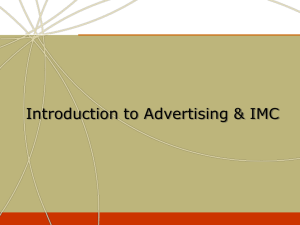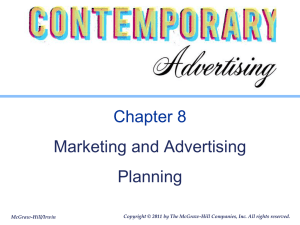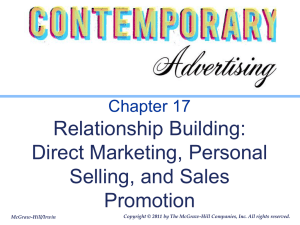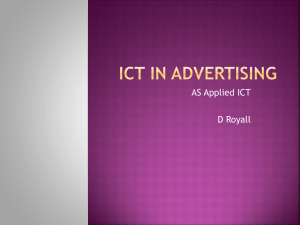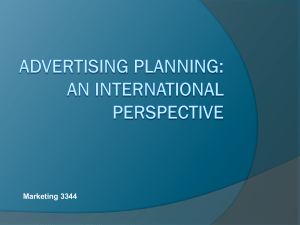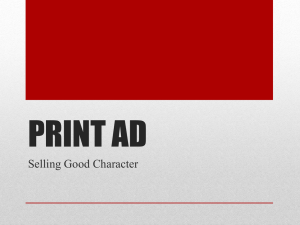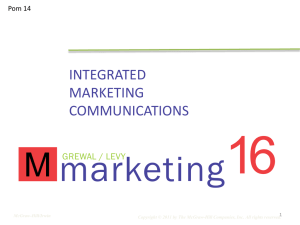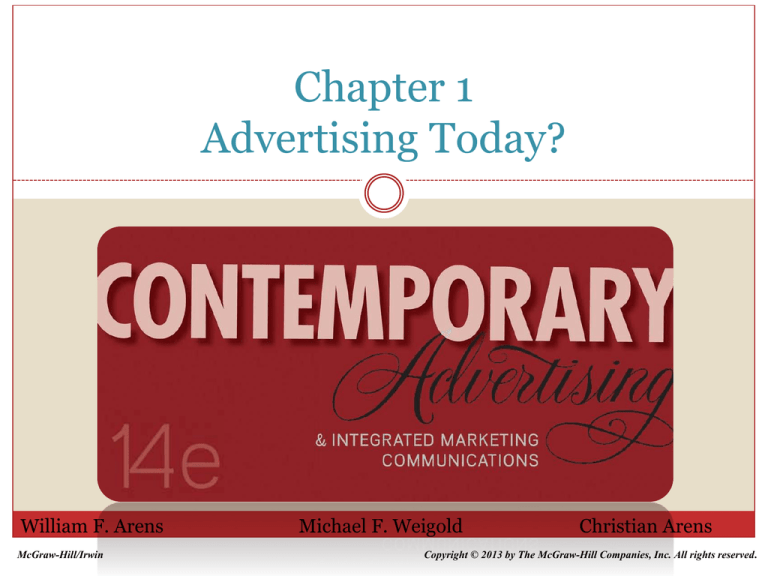
Chapter 1
Advertising Today?
William F. Arens
McGraw-Hill/Irwin
Michael F. Weigold
Christian Arens
Copyright © 2013 by The McGraw-Hill Companies, Inc. All rights reserved.
Chapter Overview
Stresses the importance of IMC to relationship
marketing; introduces advertising and
distinguishes it from other forms of marketing
communication.
1-2
Chapter Objectives
Define integrated market communications (IMC)
Explain the importance of relationship marketing
Explain how the basic human communication
process is useful in advertising communication
Define advertising and distinguish it from other
forms of marketing communications
1-3
Chapter Objectives
Define marketing and identify the 4 elements of
marketing strategy
Illustrate advertising’s role in marketing strategy
Identify important categories under promotion: the
communication element of strategy
1-4
Q. 1. Define Relationship Marketing.
1-5
Relationship Marketing
Relationship marketing – creating, maintaining, and
enhancing long term relationships with stakeholders that
result in exchanges of mutual value
1-6
Relationship Marketing
Manage
customer/
company
contacts
Maximize
value of
profitable
customers
Use data to
know
customer
Goals
1-7
Q. 2. Why is it important for
organizations to build relationships?
1-8
Importance of Relationships
Cost of lost customers
Lifetime Customer Value
(LTCV)
Cost of acquiring new
customers
Value of loyal
customers
1-9
Q. 3. What are the five levels of
relationships?
1-10
Relationship Levels
Transactional
Reactive
Accountable
Proactive
Partnership
1-11
Customer/Profit Relationships
Profit Margins
High
Medium
Low
Accountable
Reactive
Transactional
Medium Proactive
Accountable
Transactional
Few
Accountable
Reactive
Many
Number
of
Customers
Partnership
1-12
IMC Tactics
Mass media
Less advertising in
mass media
Target
messages
Heavier reliance on targeted
messages
Consumer
data
Increased use of consumer data
Expectations
Changed expectations for
marketing communication
suppliers
1-13
Affects on Customer View
IMC helps
company
manage
customer
perceptions
News
Financial
report
Word of
mouth
Product
view
CEO
personality
Gossip
Web
Expert
opinion
1-14
Q. 4. What are the four sources of
brand messages?
1-15
4 Sources of Brand Messaging
1.
Planned messages
(advertising, publicity releases)
Low impact
2.
Product messages
(product, price, packaging)
Great impact
3.
Service messages
(employee interactions)
Positive or
negative
4.
Unplanned messages
(news stories, rumors,
competitors remarks, disasters)
Company can
influence
1-16
Dimensions of IMC
The
Integration
Triangle
Say
Planned
messages
Confirm
Unplanned
messages
Do
Product,
service
messages
1-17
Q. 5. Define Advertising.
1-18
What is Advertising?
Structured, composed communication
Directed to groups
Paid for
Usually persuasive
About products
Identified sponsors
Transmitted through
a communication medium
1-19
Dimensions of Advertising
Communication
Economic
Marketing
Social/Ethical
1-20
Q. 7. What are the various elements in
the human communication process?
1-21
Human Communication Process
Noise
Source
Encoding
Message
Decoding
Channel
Receiver
Feedback
1-22
Interactive Communication Model
Encoder
Source
Decoder
Feedback
Message
Decoder
Receiver
Encoder
1-23
Stern Communication Model
1-24
Q. 9. Who are the sources and
receivers in a message according to
the Stern model?
1-25
Communication: Source Dimensions
Sponsor
• Legally responsible
• Has a message
Author
• Copywriter, art director,
creative group
• Invisible to audience
Persona
• Within the text
• Lends voice or tone to ad
• Real or imaginary
spokesperson
1-26
Receiver Dimensions
Implied
consumers
• Every ad or commercial
assumes an audience of ideal
consumers
Sponsorial
consumers
• Decision makers at the
sponsor’s organization
• They decide if the ad will run
Actual
consumers
• People in the real world who
comprise the target audience
1-27
Q. 8. What three literary forms are
used in advertising messages?
1-28
Communication: Message Dimensions
Autobiography
“I” tell a story about
myself to “you,” the
imaginary audience
Narrative
Third person persona tells a
story about others to
imagined audience
Drama
Characters act in front
of imagined empathetic
audience
1-29
Feedback and Interactivity
Redeemed
Coupons
Phone
Inquiries
Visits to
Web site
Feedback &
Interactivity
Survey
Responses
Increased
Sales
Visits to
a store
Lets sender know if message received, understood
Sender can tell when communication breaks down
1-30
The Marketing Dimension
Business
Functional Divisions
Operations
Finance &
Admin
Marketing
Defines advertising’s role in business
Only marketing has revenue generation
as primary role
1-31
What is Marketing?
• The process of planning and
executing…
• Concepts, pricing, distribution, and
promotion of
• Ideas, goods, and services
• To create exchanges that…
• Satisfy the perceived needs, wants,
and objectives of individuals and
organizations
1-32
Advertising Classifications
Target Audience
Geographic Area
Medium
Purpose
1-33
Target Markets and Audiences
Consumer Markets
Retail & Public Service
Business/Industrial Markets
Trades, Professions, & Agriculture
1-34
Marketing: The 4 Ps
Product
Categories of
goods or services
Price
Strategies for
competitive pricing
Place
Distribution and
geography
Promotion
Communication
channels
1-35
Q. 10. How are the 4Ps related to
advertising strategy?
1-36
Marketing Communications (Marcom)
Collateral
Materials
Types of
Marketing
Communication
Personal
Selling
Public
Relations
Product
Advertising
Sales
Promotion
1-37
Marketing: IMC
Less-efficient
advertising
New media
proliferation
More
competition
Higher costs
Cynical,
untrusting,
sophisticated
consumers
Gaps between
promise &
delivery
Movement to
establish
consistency
among agencies
& departments
Need for more
relationship
building
1-38
Marketing: IMC
Integrated Marketing
Collateral
Materials
Personal
Selling
Public
Relations
Sales
Product
Promotion Advertising
1-39

